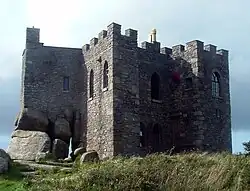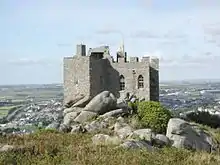| Carn Brea Castle | |
|---|---|
 South side, photo taken in 2009 | |
 Location in Cornwall | |
| General information | |
| Location | Carn Lane, Carnkie, Redruth, Cornwall |
| Coordinates | 50°13′20.85″N 5°14′41.40″W / 50.2224583°N 5.2448333°W |
Carn Brea Castle on Carn Brea is a 14th-century grade II listed granite stone building which was extensively remodelled in the 18th century as a hunting lodge in the style of a castle for the Basset family. The building is in private use as a restaurant.[1]
Description
The castle is a small stone folly decorated in the romantic ideal style of a medieval/gothic castle. It has an irregular layout with four rectangular turrets round a core of the same height and an embattled parapet. The building is built into a large stone outcrop with a steep drop on the rear. The building was designed as a hunting lodge rather than a dwelling and measures 60 by 10 feet (18.3 by 3.0 m).[2]
History

The castle was originally built as a chapel, in 1379, thought to be dedicated to St Michael.[3] Antiquarian William Worcester recorded that there were 32 castles on the Cornish peninsula, including Carn Brea which was described as a tower.[4]
The castle was extensively rebuilt in later periods, primarily in the 18th century by the Basset family as a hunting lodge.[5] It is considered a folly, due to the huge uncut boulders that make up part of its foundations, giving the impression of the building melting into the land.[6]
Its use as a beacon for ships was recorded in 1898 when stipulated in the lease, the tenant agreeing to show a light in the north facing window. The castle had periods of disuse and disrepair in the 1950s to 1970s, until private renovation in 1975-1980. The building was classed by English Heritage as grade II listed in 1975.[7]
In the 1980s the building was converted into a Middle Eastern cuisine restaurant.[8]
Media interest
- A 19th-century East India trading ship was named after Carn Brea Castle. It was wrecked off the Isle of Wight in 1829 and reported in The Times as being involved in excise tax fraud.[9]
- Carn Brea castle appeared in the 1983 James Bond film Never Say Never Again, as two air-launched cruise missiles armed with nuclear warheads fly over the English countryside and out to sea, passing directly over as well as the nearby Basset monument viewed through the missiles head-up display.
- The stolen Ford Anglia featured in the Harry Potter films was found at the Castle in 2006.[10]
See also
References
- ↑ Chapman, Sarah; Chapman, David (2008), Iconic Cornwall, Alison Hodge Publishers, p. 16, ISBN 978-0-906720-57-8
- ↑ Society for the Diffusion of Useful Knowledge Great Britain (1837), The Penny Cyclopædia of the Society for the Diffusion of Useful Knowledge, Volume 8, C. Knight, p. 40
- ↑ "About Carn Brea". Carn Brea Protection Group. Archived from the original on 29 September 2007. Retrieved 20 August 2007.
- ↑ Drake, S. J. (2019). Cornwall, Connectivity and Identity in the Fourteenth Century. Boydell & Brewer. p. 10. doi:10.2307/j.ctvktrxzx. ISBN 978-1-78327-469-7.
- ↑ "Pictures of Carn Brea". Parish of Saint Illogan. Archived from the original on 8 August 2001. Retrieved 20 August 2007.
- ↑ "Carn Brea Castle, Follies and Monuments". FollyTowers.com. Archived from the original on 29 August 2007.
- ↑ Historic England. "Details from listed building database (1160284)". National Heritage List for England. Retrieved 28 October 2010.
- ↑ "Carn Brea Castle". Eat Out Cornwall. Archived from the original on 29 September 2007.
- ↑ "Some frauds of a very peculiar and extensive nature have been discovered". The Times. 18 July 1829. p. 4.
- ↑ "The Scotsman: Harry Potter's stolen car appears at castle". The Scotsman Publications Ltd. 19 May 2006. Retrieved 30 October 2006.
External links
 Media related to Carn Brea Castle at Wikimedia Commons
Media related to Carn Brea Castle at Wikimedia Commons- Time-lapse video of Carn Brea Castle.